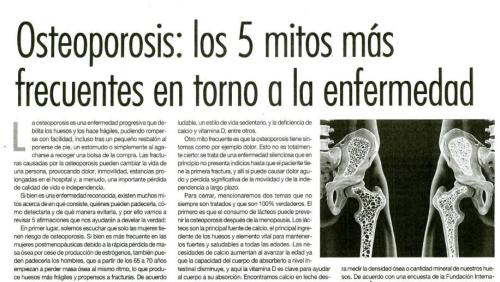LATEST NEWS
- All news
-
44Awards
-
8Burden of Osteoporosis
-
66Capture the Fracture
-
1Exercise
-
8FRAX
-
83IOF
-
31IOF Positions and Statements
-
1IOF Tour Latin America
-
20Meetings
-
56Member News
-
8Nutrition
-
35Policy
-
6Prevention
-
43Research
-
25Scientific Journals
-
13Skeletal Rare Diseases
-
7Training Courses
-
14Treatment
-
29World Osteoporosis Day
- News room - Latin America Region
In Argentina, IOF article in La Prensa raises awareness of osteoporosis

Highlighting the topic of osteoporosis in the media is an important way of raising awareness among the public. The following opinion piece, authored by Lic. Mónica Caló, International Osteoporosis Foundation (IOF) Regional Manager for Latin America, was originally published in the February 4th, 2024 print edition of Argentina's La Prensa newspaper in Spanish.
See Spanish-language version
Osteoporosis: the five most frequent myths around the disease
Osteoporosis is a progressive disease that weakens bones and makes them fragile and easily breakable, even after a small slip from standing height, a sneeze or simply bending down to pick up a shopping bag. Fractures caused by osteoporosis can change a person's life, causing pain, immobility, prolonged hospital stays and often a significant loss of quality of life and independence.
Although it is a recognized disease, there are many myths about what it is, who can get it, how to detect it, and how to avoid it, so we are going to look at 5 claims that will help us uncover the truth:
Firstly, we often hear that only women are at risk of osteoporosis. Although it is more common in post-menopausal women due to the rapid loss of bone mass due to the cessation of estrogen production, it can also occur in men, who from the age of 65 to 70 start to lose bone mass at the same rate, resulting in bones that are more fragile and prone to fractures. According to the WHO, 1 in 3 women, and 1 in 5 men, will suffer a fracture after the age of 50 at some point in their lives.
Another common assertion is that we should be concerned about osteoporosis only at older ages. Some of this is true, and some of it is a myth: older age puts people at greater risk of osteoporosis and fragility fractures, but other risk factors can affect people at younger ages. While age and menopause are very important factors in developing osteoporosis, there are other issues to take into account such as genetics (family history), having suffered a fragility fracture (which presents twice the risk of suffering a fracture in the future compared to someone who has never had a fracture), as well as health conditions and the use of certain medications, such as corticoids for example. Their use even for periods of 3 months has been associated with osteoporosis. There are also risk factors that patients can modify such as smoking, excessive alcohol consumption, unhealthy low weight, a sedentary lifestyle, and calcium and vitamin D deficiency, among others.
Another common myth is that osteoporosis has symptoms such as pain. This is not entirely true: it is a silent disease that initially shows no signs until the patient has experienced the first fracture, where it can cause acute pain and significant long-term loss of mobility and independence.
In closing, we will mention two issues that are not always addressed and which are 100% true. The first is that dairy consumption can help to prevent osteoporosis after menopause. Dairy foods are the main source of calcium, and calcium is the main ingredient in bones and a vital element in keeping them strong and healthy at all ages. Calcium needs increase with advancing age as the body's ability to absorb it in the gut decreases, and here vitamin D is key to helping the body absorb it. Calcium is found in skimmed and lactose-free milk, cheese, yoghurt, and nuts, including almonds, and also in some green vegetables such as broccoli.
Finally, I would like to point out that we can to some extent prevent or reverse the effects of osteoporosis. Although the disease cannot be completely reversed, it can be treated in a way that allows patients to live active and productive lives. To do this, there are some key strategies, such as: aiming for a bone-healthy diet, engaging in regular physical exercise to maintain bone mass and muscle strength (especially balance and posture-enhancing activities), avoiding negative lifestyle habits, and consulting about your bone health if you have any risk factors. In this regard, the best way to diagnose osteoporosis is to consult a doctor for bone densitometry. This is a form of technology that uses a small dose of radiation to produce images, usually of the lower spine and hips, to measure the bone density or mineral content of our bones.
The findings of an IOF survey of more than 7,000 women over 60 in five countries revealed that bone fractures affect almost one in two women in this age group but that, paradoxically, bone health is often overlooked in medical check-ups. Bone densitometry is the gold standard for diagnosing osteoporosis, and assessing a person's risk of developing fractures. It is simple, quick, and non-invasive.
Osteoporosis is a disease that occurs often in the population and, as I mentioned earlier, its symptoms are often silent, so it is important to be aware of the risk factors to make a proper and timely diagnosis. Hopefully, 2024 will find us informed about what situations we should be alert to, and who may suffer from this disease.
Want to know more about osteoporosis and how to take care of your bones? Follow our social networks in Spanish Instagram @osteoporosis.iof or Facebook - IOF America Latina